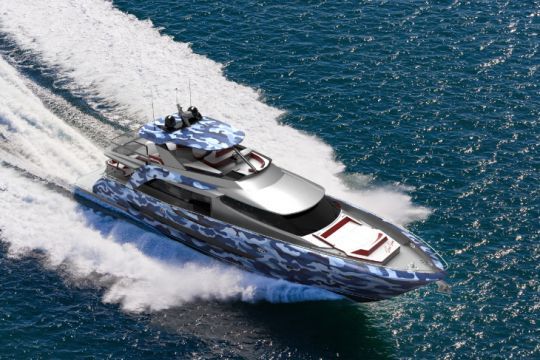Looking to set sail on a luxurious yacht but tired of the same old steel and wood construction? Look no further, because the world of yacht construction is evolving to incorporate innovative materials that are pushing the boundaries of design and functionality. In this article, we will explore the exciting world of alternative materials being used in the construction of yachts. From lightweight composites to sustainable options, we will discuss how these materials are revolutionizing the industry and creating unforgettable experiences for yacht enthusiasts like you. So, buckle up and prepare to be amazed by the possibilities that lie beyond steel and wood.
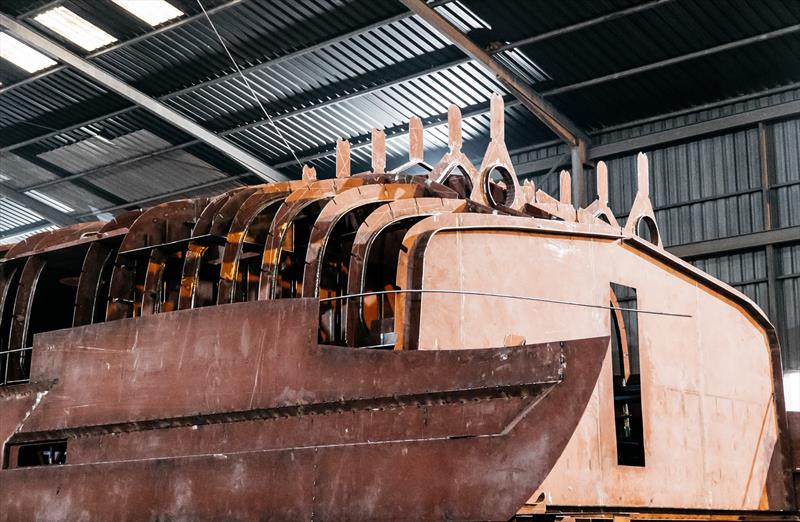
This image is property of powerboat.world.
Introduction to Innovative Materials in Yacht Construction
Yachts have long been associated with luxury and elegance, but behind their glamorous exteriors lies a world of innovative materials that make these vessels not just beautiful, but also strong, durable, and efficient. The use of advanced materials in yacht construction has revolutionized the industry, providing incredible possibilities in terms of design, performance, and sustainability. In this article, we will explore the importance of these materials in yacht construction, the evolution of their use, and the many benefits they offer.
Importance of materials in yacht construction
The choice of materials plays a crucial role in the construction of yachts. It affects the vessel’s strength, weight, performance, and overall quality. Traditional materials like steel and wood have been used for centuries, but advancements in technology and the quest for better performance have led to the development and adoption of innovative materials. These materials not only offer superior properties but also help yacht builders push the boundaries of design and functionality.
Evolution of materials in yacht construction
Yacht construction has come a long way in terms of materials used. Early yachts were primarily made of wood, offering the necessary strength but often requiring significant maintenance. However, as technology progressed, new materials were introduced to the industry, allowing for greater creativity, performance, and durability. The evolution of materials in yacht construction has paved the way for innovative designs and enhanced functionality, enabling yacht builders to create vessels that surpass expectations.
Benefits of using innovative materials
The use of innovative materials in yacht construction brings a multitude of benefits. Firstly, these materials offer significant weight savings compared to traditional options, resulting in improved fuel efficiency, speed, and maneuverability. Moreover, innovative materials often provide enhanced strength and durability, ensuring the yacht can withstand harsh conditions and demanding use. Additionally, these materials offer more design flexibility, allowing for unique and striking aesthetics that set yachts apart from one another. Lastly, many innovative materials now boast eco-friendly properties, aligning with the growing demand for sustainable and responsible yacht construction.
Composites
Definition and types of composites
In the world of yacht construction, composites refer to materials made by combining two or more individual materials to create a new material with improved characteristics. Composites used in yacht construction are typically a combination of a reinforcing material, such as fiberglass or carbon fiber, and a matrix material, such as epoxy resin. These composites offer a wide range of advantages over traditional materials, making them a popular choice among yacht builders.
Fiberglass composites
Fiberglass composites, also known as glass-reinforced plastics (GRP), are widely used in yacht construction due to their strength, lightness, and ease of fabrication. Fiberglass composites consist of a glass fiber reinforcement embedded in a matrix of plastic resin, usually epoxy or polyester. This combination offers excellent resistance to corrosion, impact, and fatigue, making it highly suitable for marine applications. Fiberglass composites also provide good insulation and are relatively inexpensive compared to other composite materials.
Carbon fiber composites
Carbon fiber composites have gained immense popularity in recent years, particularly in high-performance yacht construction. Carbon fiber composites are made of thin strands of carbon fibers embedded in a matrix material, often epoxy resin. These composites offer exceptional strength, stiffness, and weight savings, making them ideal for use in yacht construction. Carbon fiber composites enable yacht builders to create lightweight structures without compromising on strength or performance, resulting in faster and more agile vessels.
Advantages of composites in yacht construction
The use of composites in yacht construction offers numerous advantages. Firstly, composites are lighter than traditional materials, leading to improved fuel efficiency, higher speeds, and increased maneuverability. Additionally, composites exhibit superior strength and stiffness properties, ensuring the yacht can withstand the challenging conditions of the open sea. Furthermore, composites provide more design flexibility, enabling yacht builders to create sleek and visually striking vessels. Lastly, composites are corrosion-resistant, reducing the need for extensive maintenance and increasing the longevity of the yacht.

This image is property of alliedyachting.com.
Aluminum
Advantages of aluminum in yacht construction
Aluminum has become a popular choice in yacht construction due to its unique properties and advantages. Firstly, aluminum is lightweight, offering significant weight savings compared to steel. This weight reduction translates into improved fuel efficiency and higher speeds. Secondly, aluminum is highly corrosion-resistant, eliminating the need for extensive maintenance and preventing deterioration over time. Additionally, aluminum offers excellent strength and durability, ensuring the yacht can withstand harsh conditions. Lastly, aluminum is easily recyclable, making it an environmentally-friendly choice for responsible yacht construction.
Aluminum alloys used in yacht construction
In yacht construction, various aluminum alloys are used to provide the desired characteristics and performance. The most commonly used aluminum alloy is 5083, which offers a good balance of strength, corrosion resistance, and workability. Other alloys, such as 6061 and 6082, are also used in specific applications, each with its own set of properties. The choice of aluminum alloy depends on factors such as the yacht’s intended use, size, and design requirements.
Challenges and considerations with using aluminum
While aluminum has many advantages, there are also some challenges and considerations associated with its use in yacht construction. Firstly, the initial cost of aluminum can be higher than other materials, which may deter some yacht builders. Additionally, aluminum requires specialized welding expertise, resulting in increased labor costs during construction and repairs. Furthermore, aluminum structures can be subject to galvanic corrosion if not properly insulated from other metals. Lastly, aluminum can be susceptible to fatigue if not designed and built to withstand the dynamic loads experienced by yachts.
Titanium
Unique properties of titanium
Titanium is a material with exceptional properties that make it highly desirable for various industries, including yacht construction. Firstly, titanium has an exceptional strength-to-weight ratio, surpassing that of many other metals. This characteristic enables the creation of lightweight yet strong structures, translating into increased performance and efficiency. Secondly, titanium is highly corrosion-resistant, making it ideal for marine environments where exposure to saltwater is constant. Lastly, titanium possesses excellent fatigue resistance, allowing yachts to withstand years of use without compromising structural integrity.
Applications of titanium in yacht construction
In yacht construction, titanium is primarily used in critical components that require strength, durability, and resistance to corrosion. One of the prominent applications of titanium is in the construction of propeller shafts, where its high strength and resistance to marine corrosion are crucial. Titanium is also used in fittings, fasteners, and various interior and exterior components. While the use of titanium in yacht construction is limited due to its high cost, its specific properties make it an attractive choice for certain applications.
Benefits and drawbacks of using titanium
The use of titanium in yacht construction offers notable benefits. Firstly, titanium’s lightweight nature contributes to improved fuel efficiency and higher speeds, enhancing overall performance. Secondly, its exceptional corrosion resistance reduces the need for regular maintenance and extends the lifespan of the yacht. However, there are some drawbacks to consider, including the high cost of titanium compared to other materials. Additionally, working with titanium requires specialized skills and equipment, leading to increased manufacturing and repair costs.
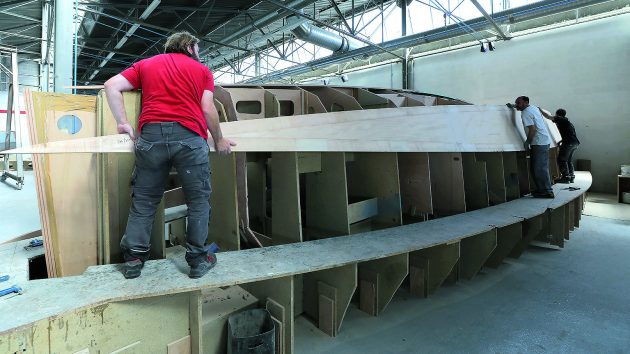
This image is property of keyassets.timeincuk.net.
Glass Reinforced Plastic (GRP)
Characteristics of GRP
Glass Reinforced Plastic (GRP), also known as fiberglass, is a composite material made of glass fibers embedded in a matrix of plastic resin. GRP offers a range of characteristics that make it suitable for yacht construction. Firstly, GRP provides high strength-to-weight ratios, resulting in lightweight structures without compromising strength. Secondly, GRP is highly resistant to corrosion, making it ideal for marine environments. Additionally, GRP is relatively easy to mold, allowing for complex shapes and designs. Lastly, GRP offers good insulation properties, providing comfort and energy efficiency on board.
Applications and techniques in yacht construction
GRP has been widely used in yacht construction for many years due to its favorable properties. It is commonly used in the hulls, decks, and superstructures of yachts. The construction of GRP yachts involves laying up layers of fiberglass fabric soaked in resin and then curing the material to form a solid structure. Vacuum infusion techniques are also employed for larger and more intricate components to ensure optimal resin distribution. GRP’s versatility and ease of fabrication make it a top choice for both production and custom yacht builders.
Advantages and limitations of GRP
GRP offers several advantages in yacht construction. Firstly, its excellent strength-to-weight ratio contributes to fuel efficiency, higher speeds, and improved handling. Secondly, GRP’s corrosion resistance reduces maintenance requirements and increases the longevity of the yacht. Additionally, GRP provides noise and thermal insulation, enhancing comfort on board. However, GRP does have some limitations, including a potential for osmosis if not properly protected against water penetration. Additionally, repair work on GRP structures can be complex and time-consuming.
Bamboo
Sustainable properties of bamboo
In recent years, there has been a growing interest in sustainable materials for yacht construction, and bamboo has emerged as a promising option. Bamboo is a fast-growing grass that can be harvested sustainably, making it an eco-friendly choice. It requires minimal water, no fertilizers or pesticides, and its cultivation helps reduce carbon dioxide levels. Bamboo also exhibits excellent strength-to-weight ratios, making it a viable alternative to traditional materials like wood.
Use of bamboo in yacht construction
Bamboo is increasingly being used in yacht construction, primarily for interior elements and secondary structures. Its aesthetic appeal, strength, and versatility make it suitable for applications such as flooring, cabinetry, and decorative accents. Some yacht builders have even experimented with using bamboo as a primary construction material for hulls and decks due to its exceptional properties. While still relatively niche, the use of bamboo in yacht construction is gaining momentum as sustainability becomes a priority in the industry.
Benefits and challenges of bamboo as a material
The use of bamboo in yacht construction offers numerous benefits. Firstly, its sustainable nature aligns with the growing demand for environmentally-friendly practices. Secondly, bamboo’s strength-to-weight ratio contributes to fuel efficiency and improved performance on the water. Additionally, bamboo is aesthetically appealing, providing a unique and natural charm to yacht interiors. However, there are challenges to consider, such as the limited availability of boat-grade bamboo and potential difficulties in obtaining certifications for its use. Furthermore, the long-term durability of bamboo in a marine environment requires careful consideration and regular maintenance.
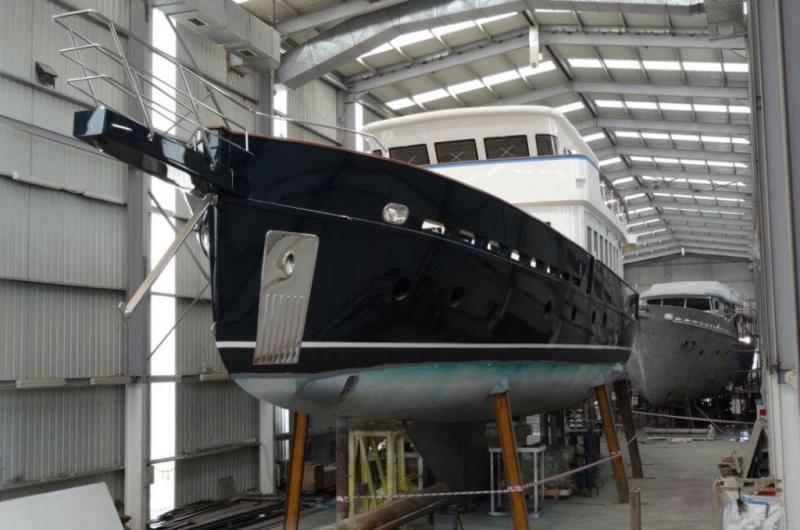
This image is property of alliedyachting.com.
Kevlar
Strength and durability of Kevlar
Kevlar is a high-strength synthetic fiber known for its exceptional tensile strength and resistance to impact. Originally developed for bulletproof vests and armor, Kevlar has found its way into various industries, including yacht construction. Kevlar provides excellent resistance to punctures and tears, making it highly suitable for applications that require durability and protection.
Applications of Kevlar in yacht construction
In yacht construction, Kevlar is primarily used for reinforcement in areas that may be subjected to high stress or impact, such as the hull, bow, and keel. Its ability to absorb and distribute energy effectively helps minimize damage from collisions or groundings. Kevlar is also used in areas where weight reduction is essential, such as structural bulkheads or supports. The use of Kevlar in these critical areas enhances the yacht’s overall strength and safety.
Advantages and considerations with using Kevlar
The use of Kevlar in yacht construction offers significant advantages. Firstly, its exceptional strength and durability improve the yacht’s ability to withstand impacts and harsh conditions. Secondly, Kevlar’s lightweight nature contributes to fuel efficiency and maneuverability. Additionally, Kevlar’s resistance to UV degradation makes it an excellent choice for exterior components exposed to sunlight. However, it is important to note that Kevlar can be relatively expensive compared to other materials, and its installation requires special expertise to ensure proper lamination and bonding.
Epoxy Resin
Properties and characteristics of epoxy resin
Epoxy resin is a versatile and widely used matrix material in composite construction, including yacht building. It offers numerous desirable properties, such as high strength, excellent adhesion, and resistance to chemicals, moisture, and heat. Epoxy resin can be combined with various reinforcing materials, such as fiberglass or carbon fiber, to create strong and lightweight composites.
Usage of epoxy resin in yacht construction
Epoxy resin is extensively used in yacht construction for laminating fiberglass composites and bonding various components together. It acts as a protective barrier, providing strength and rigidity to the composite structures. Epoxy resin’s ability to adhere well to various materials makes it suitable for joining different parts of the yacht, such as bulkheads, decks, and interiors. Its versatility and compatibility with different types of reinforcements make it a preferred choice for many yacht builders.
Benefits and precautions of epoxy resin
The use of epoxy resin in yacht construction offers several benefits. Firstly, its high strength and adhesion properties ensure durable and reliable structures. Secondly, epoxy resin provides excellent resistance to moisture infiltration, reducing the risk of water damage and osmosis. Additionally, epoxy resin’s low shrinkage and good heat resistance contribute to the longevity of the yacht. However, precautions must be taken when working with epoxy resin, as it can cause skin and respiratory sensitization. Proper protective equipment and ventilation are essential during application and curing.
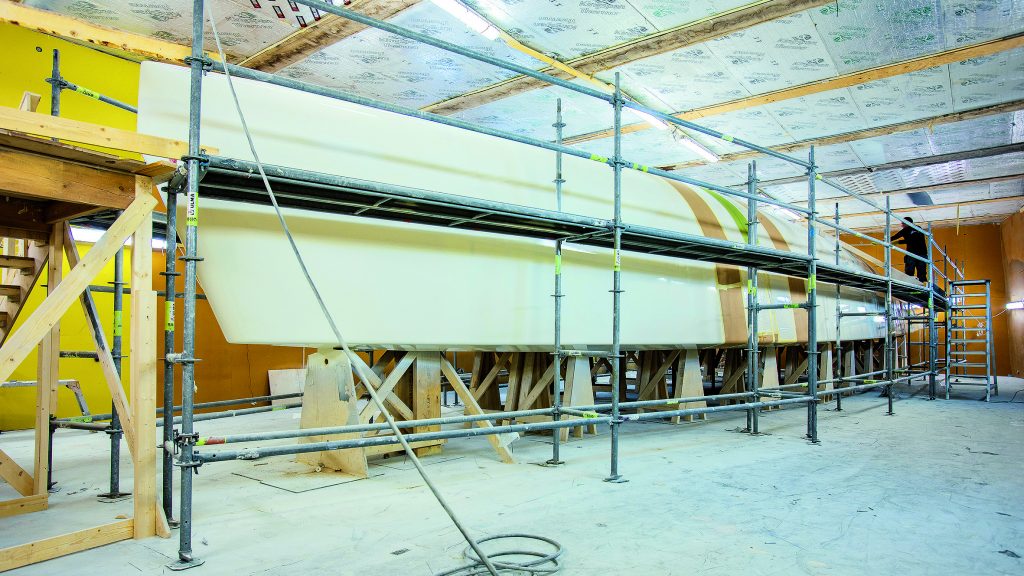
This image is property of keyassets.timeincuk.net.
Foam Core
Types of foam core materials
Foam core materials are used in yacht construction to provide lightweight and stiff structures. There are various types of foam cores available, each offering different properties and performance characteristics. One commonly used foam core material is closed-cell foam, which consists of numerous tiny cells that trap air or gas inside. Another option is honeycomb core, which consists of hexagonal cells made of a lightweight material like aluminum or aramid fiber.
Applications and advantages of foam core
Foam core materials are primarily used in sandwich panel construction, where they are sandwiched between two layers of composite material. Foam cores provide exceptional stiffness, enabling yacht builders to create lightweight yet strong structures. They also offer good insulation properties, both in terms of heat and sound. Foam cores provide buoyancy, making them suitable for applications requiring low weight and high strength, such as hulls, decks, and bulkheads.
Considerations when using foam core
While foam core materials offer significant advantages, there are considerations to keep in mind when using them in yacht construction. Firstly, the selection of the appropriate foam core material is crucial, as different types have varying properties and performance characteristics. The density and thickness of the foam core also need to be carefully determined to ensure proper structural integrity. Additionally, special attention must be given to manufacturing techniques and ensuring proper bonding between the foam core and the composite layers to prevent delamination and water infiltration.
Conclusion
Innovative materials have transformed the world of yacht construction, offering unparalleled possibilities in terms of design, performance, and sustainability. Composites, aluminum, titanium, glass reinforced plastic, bamboo, Kevlar, epoxy resin, and foam core are just a few examples of these advanced materials that have revolutionized the industry. Each material brings its own set of advantages and considerations, allowing yacht builders to create vessels that surpass expectations in terms of strength, weight, aesthetics, and eco-friendliness. As the demand for yachts continues to grow and evolve, material innovations will play a crucial role in shaping the future of yacht construction.
Looking ahead, the prospects for material innovations in yacht construction are promising. Researchers and engineers are constantly exploring new materials and testing their applicability in the maritime industry. Advances in nanotechnology, bio-based composites, and smart materials offer glimpses into the future of sustainable and high-performance yacht construction. As technology advances and new materials emerge, yacht enthusiasts can expect even greater possibilities in terms of efficiency, safety, and luxury.
In conclusion, choosing the right materials for your yacht is a critical decision that can greatly impact its performance, durability, and aesthetics. Whether you opt for composites, aluminum, titanium, glass reinforced plastic, bamboo, Kevlar, epoxy resin, or foam core, understanding the unique properties and considerations of each material is essential. Consult with experienced yacht builders, designers, and naval architects to ensure that the materials chosen align with your specific requirements and vision. With the right combination of innovative materials, your yacht can truly be a masterpiece of engineering and design, ready to conquer the seas with grace and style.

